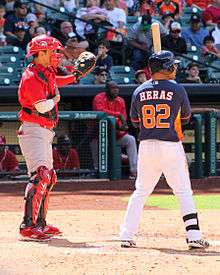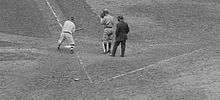Intentional base on balls
In baseball, an intentional base on balls, usually referred to as an intentional walk and denoted in baseball scorekeeping by IBB, is a walk issued to a batter by a pitcher with the intent of removing the batter's opportunity to swing at the pitched ball. A pitch that is intentionally thrown far outside the strike zone for this purpose is referred to as an intentional ball.

Beginning with the 2017 season, Major League Baseball has removed the requirement to throw four intentional balls. In MLB and in amateur baseball, such as high school and college games, and in most levels of Little League Baseball, the manager of the team on the field now simply asks the plate umpire to let the batter go to first base.[1]
Strategy
The purpose of an intentional walk is to bypass the current batter in order to face the following batter, whom the defensive team expects to be easier to put out. The penalty under the rules is that the current batter becomes a baserunner which, on average, makes it more likely that the team at bat will score.
Situations that call for the intentional walk include the following:
- With one out and a runner on second or third base, converting a powerful batter to a runner on first base means that a subsequent ground ball may become a double play that ends the scoring threat. With a runner on second, this move lets fielders put the lead runner out using a force play rather than the more difficult tag play.
- In the bottom of the ninth or an extra inning, having a runner on first base might not affect the outcome of the game at all. For example, if the game is tied and there is a runner on third base, the game is over if that runner scores. In these situations, intentional walks are quite frequent since the potential cost is negligible and the potential gain (an inning-ending force or double play) massive in win probability.
- In National League play or American League play prior to the adoption of the designated hitter in 1972, it was not uncommon for teams to intentionally walk the number 8 hitter to bring up the pitcher, in hopes of influencing the opposing manager to pinch hit for a difficult pitcher. This tactic has decreased in use in recent years as teams have assessed the potential damage from putting a relatively weak number 8 hitter on base generally outweighs the potential benefits of getting the opposing pitcher out of the game.
The intentional walk disfavors a team that has one batter who is much better than the others, as it often lets opponents "take the bat out of his hands" and opt to pitch to the next batter.
Rules and scoring
An intentional base on balls — whether achieved through intentional balls or through declaration — has the effect of any other base on balls. The batter is entitled to take first base without being put out. Any runner already on first base is awarded second base, and so on; if the bases are loaded, an intentional base on balls results in the scoring of a run.
Statistically, receiving an intentional base on balls does not count as an official at bat for a batter, but does count as a plate appearance and a base on balls. An intentional ball is counted as a ball in the count of the pitcher's balls and strikes thrown.
Semi-intentional walk
Even in leagues where a team can walk a batter by declaration, the pitcher may be instructed to "pitch around" the batter. The manager defers the decision to intentionally walk the pitcher to see whether the batter swings at bad pitches. If the count goes to three balls, where the pitcher would have to deliver an attractive pitch to hit, the manager elects the intentional base on balls. A base on balls counts as an intentional base on balls if and only if the final pitch thrown in the plate appearance is an intentional ball.
Technique
Pitching an intentional ball, like point after touchdown in football and a free throw in basketball, is designed not to be automatic. The pitcher generally aims several feet outside the strike zone, but the catcher must be in the catcher's box when it is thrown. The catcher usually must shift position to catch an intentional ball. A balk or a wild pitch could occur, enabling runners to advance who would not have advanced from the base award to the batter.
The batter can swing at an intentional ball, but cannot leave the batter's box to follow the pitch. Swinging is rarely to the batter's advantage. In the Major Leagues, there were 12 cases from 1900 through 2011 of a batter making contact with an intentional ball. In 9 of these cases, the batter reached first base safely (six by hits, one by fielder's choice, and two by errors). The batter's team won in all nine of those instances.[2] Most recently, on September 10, 2016, the Tampa Bay Rays opted to walk Gary Sanchez of the hosting New York Yankees. He drove an intentional ball to left field for a sacrifice fly.[3]
History

Before the 1920 season, the catcher was allowed to set up anywhere within a roughly 14 by 20 feet right triangle behind home plate, the back line being 10 feet behind the plate. The catcher could stand at a corner of this triangle to receive the four wide pitches, too far away for the batter to have any chance at hitting the ball. As the intentional walk became more frequent following the end of the dead ball era, batters such as Babe Ruth complained about the unfairness of it.
To give the batter a better chance (and to potentially increase scoring and attendance), major league baseball team owners (at the annual rules meeting in Chicago on February 9, 1920) initially attempted to ban the intentional base on balls by instituting a penalty that an intentional ball be counted as a balk (which would award each runner the next base). Veteran NL umpire Hank O'Day argued successfully against the proposal and the owners succeeded only in mandating that "the catcher must stand with both feet within the lines of the catcher's box until the ball leaves the pitcher's hand," a rule still in force today. The newly-redrawn catcher's box reduced the back line from 10 to 8 feet behind the plate, and with sides 3 1/2 feet (42 inches) apart.
Intentional walks have only been an officially tracked statistic since 1955.
Prior to the 2017 season, as part of Major League Baseball's efforts to improve the pace of play, the rules were amended to allow a manager to order an intentional walk by simply signaling the umpire.[1]
Records and notable occurrences
Barry Bonds holds most of the records for intentional walks, including four in a nine-inning game (2004), 120 in a season (2004),[4] 668 in his career—more than the next two players on the all-time list, Albert Pujols (309) and Hank Aaron (293), combined[5]— and 21 in the postseason.[6] Bonds, a prolific home run hitter, was a common target for the intentional walk. Nevertheless, many times the decision to walk Bonds was a futile strategy, as the San Francisco Giants still had the National League's second-best offense in 2004, scoring 820 runs. In the first month of the 2004 baseball season, Bonds drew 43 walks, 22 of them intentional. He broke his previous record of 68 intentional walks, set in 2002, on July 10, 2004 in his last appearance before the All-Star break.
There are claims that Mel Ott was also intentionally walked four times in a game against the Phillies in 1929 (see below).
Hideki Matsui drew five consecutive intentional walks in a game in Japanese High School Baseball Championship at Koshien Stadium in 1992 and became a nationwide topic of conversation.[7]
With the bases loaded
With the bases loaded, an intentional base on balls forces in a run. This might be advisable if a team with a lead of two to four runs elects to concede one run of its lead so as not to have to pitch to a batter who might hit a home run to tie the game or take the lead.
The following table shows each batter who has gotten this treatment in the history of Major League Baseball. Cases before 1955 are researched from newspaper reports, which may be subjective.[8][9]
| Date | Batter | Score sheet |
Notes |
|---|---|---|---|
| 1881-08-02 | Abner Dalrymple | Team using the strategy did not go on to win the game; case neglected by historians until 2007.[8] | |
| 1901-05-23 | Nap Lajoie | There were no outs. | |
| 1928-05-02 | Del Bissonette | It is not clear whether he was simply pitched around; the contemporary press only states that "Bissonette was treated with extreme care and finally drew a base on balls."[10] | |
| 1929-10-05 | Mel Ott | Details below. | |
| 1944-07-23 | Bill Nicholson | ||
| 1998-05-28 | Barry Bonds | ||
| 2008-08-17 | Josh Hamilton |
The Mel Ott case, which is not included in the Baseball Almanac list, was not a result of in-game strategy. On October 5, 1929, in the first game of a Giants-Phillies doubleheader, Chuck Klein took the lead for the season home run title (box score). The Phillies' manager told the pitcher to pitch around Ott so he wouldn't challenge Klein for the title. In the top of the ninth inning of the second game, the bases were full and the Giants were already well ahead of the Phillies. "The sign came from the bench to walk Ott." When the count got to 3-0, Ott swung at two wide ones but then accepted ball four and a run was forced in.[11]
A disputed anecdote[12] says that, in 1926, the Cleveland Indians elected to walk Babe Ruth with the bases loaded. This angered Ruth; he swung anyway, and the result of the time at bat was a strikeout. This may refer to the game on July 10, in which Cleveland pitcher Joe Shaute purposely walked Ruth three times. Ruth was also called out once for stepping out of the batter's box. Contemporary newspaper accounts give no indication that Ruth was walked with the bases full in that game.
Slang
The intentional base on balls is often referred to as a "four-fingered salute." This reference stems from the manager's holding up four fingers to signal an intentional walk to the pitcher or catcher. It is a "salute" to the batter that the manager admits to wanting to pitch to someone else instead.
See also
References
- Rafferty, Scott (February 22, 2017). "Major League Baseball Eliminates One of Its Most Annoying Rules". Rolling Stone. Retrieved 2017-04-11.
- Deane, Bill (Spring 2011). "Surprise Swings at Intentional Balls". Society for American Baseball Research. Retrieved July 4, 2015.
- "You can try to intentionally walk Gary Sanchez but he'll just hit an almost-homer anyway". Major League Baseball. 2016-09-10. Retrieved 2017-05-20.
- "Single-Season Leaders & Records for Intentional Bases on Balls". Baseball-Reference. Retrieved 2009-11-08.
- "Career Leaders & Records for Intentional Bases on Balls". Baseball-Reference. Retrieved 2018-07-14.
- "Postseason Batting Event Finder: From 1903 to 2017, All Teams, Intentional Walks". Baseball Reference. Retrieved July 14, 2018.
- ja:松井秀喜5打席連続敬遠
- "Intentional Bases On Balls Records by Baseball Almanac". Baseball-almanac.com. Retrieved 2014-06-20.
- Holtzman, Jerome (May 2000). "Free Pass—Players who were intentionally walked with bases loaded". Baseball Digest. Retrieved 2009-11-08.
- Holmes, Thomas (3 May 1928). "Robins Will Have Plenty to Worry Them on Western Trip". Brooklyn Daily Eagle. Brooklyn. p. 28. Retrieved 25 April 2020 – via Newspapers.com.
- Philadelphia Inquirer, October 6, 1929.
- "Intentionally walked with the bases loaded". Baseball Fever. Retrieved 2017-05-30.